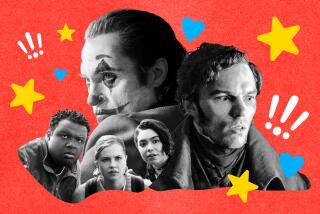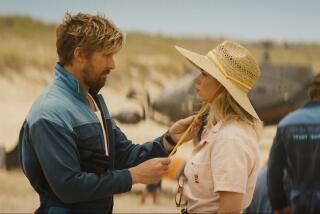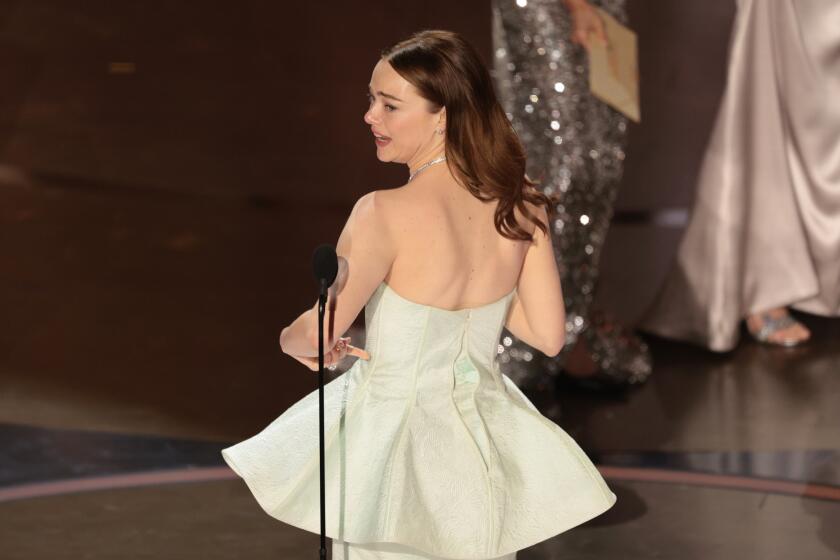CALENDAR GOES TO THE OSCARS : ON LOCATION : Mr. Monday Night : Billy Crystal’s just finished a painstaking project: directing and starring in ‘Mr. Saturday Night.’ Next: hosting the Oscars
You’ve been forewarned. You know what to expect. But the effect still catches you off guard.
Behind the camera conferring with the cinematographer is a 73-year-old man. Strolling over to a group of elderly extras to give some last-minute coaching for reaction shots, he moves gingerly. His neck appears stiff, and his shoulders hunch slightly forward. Crew members, quite unconsciously, speak slower and louder in his presence.
But the voice coming from the careworn face belongs--unmistakably--to Billy Crystal, who at 42 is one of show business’s most dynamic and youthful individuals.
Sure, filming on Castle Rock’s “Mr. Saturday Night”--in which Crystal stars, directs and co-produces a script he co-wrote--has taken an arduous 73 days to this point with 10 more to go. But it hasn’t aged him that badly, has it?
Actually, the phenomenal makeup job, which takes five to six hours to apply and another hour and a half to remove, is central to the movie. “Mr. Saturday Night” spans 60-odd years in the bittersweet life and career of stand-up comic Buddy Young Jr. (Crystal), his manager-brother (David Paymer) and Buddy’s wife (Julie Warner).
“Buddy has been a semi-success in all phases of show business,” explains Lowell Ganz, who with partner Babaloo Mandel collaborated on the script with Crystal.
“He’s been a near-hit in the Catskills, nightclubs, Vegas, B movies, early TV, talk shows. When he appeared on ‘The Ed Sullivan Show’ he went on following the Beatles--a really bad booking. So he’s now 73 and looking back at a career that might have been with envy and resentment at everything that happened and wonders why.”
All of which requires the three lead actors to perform in a series of rubber faces that indicate the aging process. According to makeup artist Peter Montagna, Crystal must spend more than half the movie in old-age makeup.
“One day I looked at myself with this hump glued to my back, two old-age hands up to mid-forearms and a face and wig that looked like somebody dipped me into an old guy, and I started to laugh,” Crystal muses. “ ‘What am I doing?’ I wondered.”
What he’s doing is making his dream movie. A lifetime of research has gone into this story.
Buddy Young Jr. has been a work in progress for more than nine years. Crystal originated the character, then conceived as a cliched Vegas comedian, for his 1982 HBO special “A Comics Line.” Crystal later refined Buddy for “Saturday Night Live” and his 1986 award-winning HBO special “Don’t Get Me Started” (whose title became Buddy’s catch phrase).
“I love playing this guy,” Crystal says. “I can’t explain it. Maybe it’s my worst nightmare of time passing by and not being funny anymore. But I love the authenticity of doing a character like this. The comics of his era fascinate me. I grew up watching these guys on ‘The Ed Sullivan Show.’ So I wanted to tell Buddy’s story, but I wanted to tell it honestly.”
That honesty involves making Buddy not only self-destructive, but also a thoroughly unpleasant person. Which creates a film that Crystal refers to as “ ‘Raging Bull’ with laughs.”
“Buddy is an unlikable person, but Billy Crystal’s own persona comes out and that compensates,” says Crystal’s longtime manager, Buddy Mora. “With somebody else (playing the role) it might not work as well.”
Drawn from eight to 10 real-life comics--”but we’re not saying who, because this is no love letter,” Ganz insists--Buddy is his own worst enemy. Yet he fails to recognize this fact.
“Usually movies show self-destructive behavior in terms of drugs or booze with people like Jim Morrison or Billie Holiday or Lenny Bruce,” Crystal says.
“But Buddy’s self-destructiveness is very interesting because it’s about fear--that scared feeling of not being good enough. We all have little terrorists in the mind that don’t let us succeed as much as we can. That feeds into a kind of fury that makes people not behave as they should. It’s envy and jealousy, the ‘who’s-working-and-I’m-not?’ feeling that exists a great deal not only in the comic world but throughout show business.
“Moments of my life are plugged in too. I had a series at NBC in 1982 with low ratings that was not backed by the network and was floundering. It was a tough period for me. ‘Soap’ had been canceled and ‘The Billy Crystal Comedy Hour’ was rushed onto the air before it was ready. The network didn’t even call me to tell me they canceled it. It was in the trades that day.
“So I understand the panic Buddy feels, that helpless, scared feeling the end is coming and someone can take something away from you (that) you want to succeed.”
Clearly, Buddy Young Jr. functions as an alter ego for Crystal. “As Buddy he can get away with stuff that Billy can’t,” Montagna says.
Crystal is, of course, a brilliant performing comedian. Years spent in clubs like the Other End in New York, the Comedy Store in Los Angeles and the Boarding House in San Francisco helped him hone a first-rate sense of mimicry and satire. This, combined with an ability to crawl inside a host of funny but often poignant characters, has made Crystal, unlike Buddy, a huge success in comedy and led to accomplishments as a writer and performer in television and film.
The $123-million domestic box-office gross for his last film, Castle Rock’s “City Slickers”--the top-grossing comedy of 1991--put him in the position not only to make his dream project but to direct it as well.
“With this film Billy will emerge as a major creative force in the industry,” predicts Martin Shafer, who heads Castle Rock’s motion picture activities. “Like Kevin Costner directing ‘Dances With Wolves,’ this adds a whole new element for Billy.”
But Crystal’s dream project has also been something of a nightmare.
The regimen of applying 14 overlapping pieces of foam latex with medical adhesive along with a nose, assorted wigs and hair pieces required getting Crystal to the set sometimes as early as 2 a.m. The effect of these prosthetics on the skin is brutal.
“Billy’s in makeup almost 50 days scattered through the movie,” says Montagna, who has done Crystal’s makeup since they first met in 1984 on “Saturday Night Live.” “I told him that the only way his skin would survive is if we do three days on and four days off.”
But in New York, where the film began shooting, Crystal went 10 straight days in old-age makeup. “His skin looked like he’d gone a few rounds with Sugar Ray Leonard,” says Crystal’s co-producer, Peter Schindler.
The shooting schedule expanded when the makeup team discovered that it couldn’t cut down the time needed in makeup.
The early days were fraught with tension and frustration over makeup and continual re-shooting of scenes in which the makeup showed. “I didn’t know what the rubber was doing,” Crystal says. “You’d do a good scene, catch dailies and say, ‘Oh, God, you can see a seam!’
“It was”--he pauses--”an adventure.”
Then too the constant switches in production chores initially troubled Crystal. “It was hard for Billy to go from directing to acting,” Schindler says. “Now he arrives at his character quicker.”
By Day 73 he’s feeling so chipper he plans to attend a Clippers basketball game that night. “I have to force myself to have a life away from all the makeup, acting, producing, directing and worrying about every sliver of this film,” he says. “Besides, I love going to the games.”
“Putting on the makeup, then working a full day is so draining,” says co-star and fellow makeup sufferer Paymer. “I don’t know how Billy can do that and direct also.”
Crystal’s energy recalls Sir Laurence Olivier’s dictum about talent being an adjunct of stamina. “My theory is he isn’t wearing makeup,” Babaloo Mandel says. “He’s really aging.”
Julie Warner has another theory. “This project is his baby. He wrote it with Babaloo and Lowell; he’s directing, producing, starring. I mean, if he’s not excited about it, who’s going to be? I think that’s the source of his energy.”
On the set several days later, Crystal, Paymer and Warner do a scene from the ‘50s that allows them to play close to their correct ages. The three watch Sid Caesar on an early black-and-white television set in Buddy’s living room.
As the camera rolls, Paymer and Warner roar with laughter at Caesar’s antics, but Crystal’s Buddy glares at the tube. Buddy knows he can’t measure up to Caesar’s comic genius.
“Putting that (Caesar) clip into the picture is very emotional to me,” Crystal says later. “My first remembrance of laughing, of seeing a funny person, was Sid Caesar in a ‘King and I’ parody on his show. He came out as the king of Siam, looking like Yul Brynner, and yelled, ‘Who’s been smoking in the palace?’ I laughed so hard. Sid and Mel (Brooks) and Carl Reiner are the reasons why I wanted to become a funny person.”
Ganz notes that “Billy is a great fan of comedy and these old comics. He just loves everything about the work--the clubs, their lives and how they make a mess of everything. I think this is the picture he’s always wanted to make.”
Crystal admits to being “frightened to death” as a first-time director before filming. With the anticipated makeup problems, he felt he had to be, if anything, overprepared for each day’s shoot.
So before production began, he and his cinematographer, Donald Peterman, screened countless movies.
“We made reels of scenes and shots and lighting we liked, then went through the script and plugged the ideas in,” Crystal says. “Moments like the way Woody (Allen) walks through a doorway in ‘Stardust Memories.’ I’d say, ‘We might be able to use that when Buddy comes in at night.’ After a while, your own style and point of view flow out of these ideas.”
Crystal’s style owes an acknowledged debt to films like “Zelig” and “This Is Spinal Tap.” Levels of reality mingle as Crystal’s fictional comic mingles in one Friars Club scene with Jerry Lewis, Jackie Gayle, Carl Ballantine and Slappy White. Period photos show Buddy with his arms around Frank Sinatra and Dean Martin in their Rat Pack days. The sequence involving “The Ed Sullivan Show” combines archival footage of the Beatles’ appearance with a Sullivan impersonator.
For the brothers’ home in 1930s Brooklyn, Crystal turned to memories of his grandmother’s house there. “When he walked on the set,” says production designer Albert Brenner, “Billy commented that it lacked the smell he remembered from his grandmother’s house. So the set director and I hurried to fry onions and got jars of horseradish and rubbed it on the doorjambs.”
“When the actors came in the next day,” Crystal recalls, “they went wild. It made it comfortable acting. In Culver City, we had Ocean Avenue in Brooklyn.”
The search for authenticity extends to the laughs for Buddy’s stand-up routines. “I don’t like laugh tracks,” Crystal explains. “So after shooting a routine, I mime the entire act for the extras. I go crazy. That way I have 30 to 40 minutes of pure laughs. We cater to the extras a lot because it’s so important to get the right laughs.”
As the film wrapped, Crystal faced his next gig--as host of Monday’s Oscar ceremonies. An exhausted performer, he laughs at the obvious question.
“I’m not sure why I’m doing the Oscars. I’m so tired. I enjoy doing it, but it’s hard to think about writing ‘Silence of the Lambs’ jokes just after finishing shooting. I’d rather make another movie. Next week I’ll face a real test: I’m going to try to walk and not shuffle to the bathroom. Once I get into a character, I really stay there.”
So closely does Crystal identify with the character, makeup artist Montagna says, that “he starts to make up as Billy, but once he gets into the makeup his attitude and way of speaking change. He becomes Buddy Young Jr. for a whole day.”
And some of those old-age days can last 20 hours. Crystal acknowledges that he is cranky and tired on such days.
“Don Peterman is noticeably happier on days with no makeup,” he says. “He cracked me up the other day when, as we wrapped, he called out cheerfully, ‘See you tomorrow,’ then his face fell. ‘Oh, you’re going to be the other guy then, aren’t you?’ ”
More to Read
Only good movies
Get the Indie Focus newsletter, Mark Olsen's weekly guide to the world of cinema.
You may occasionally receive promotional content from the Los Angeles Times.






